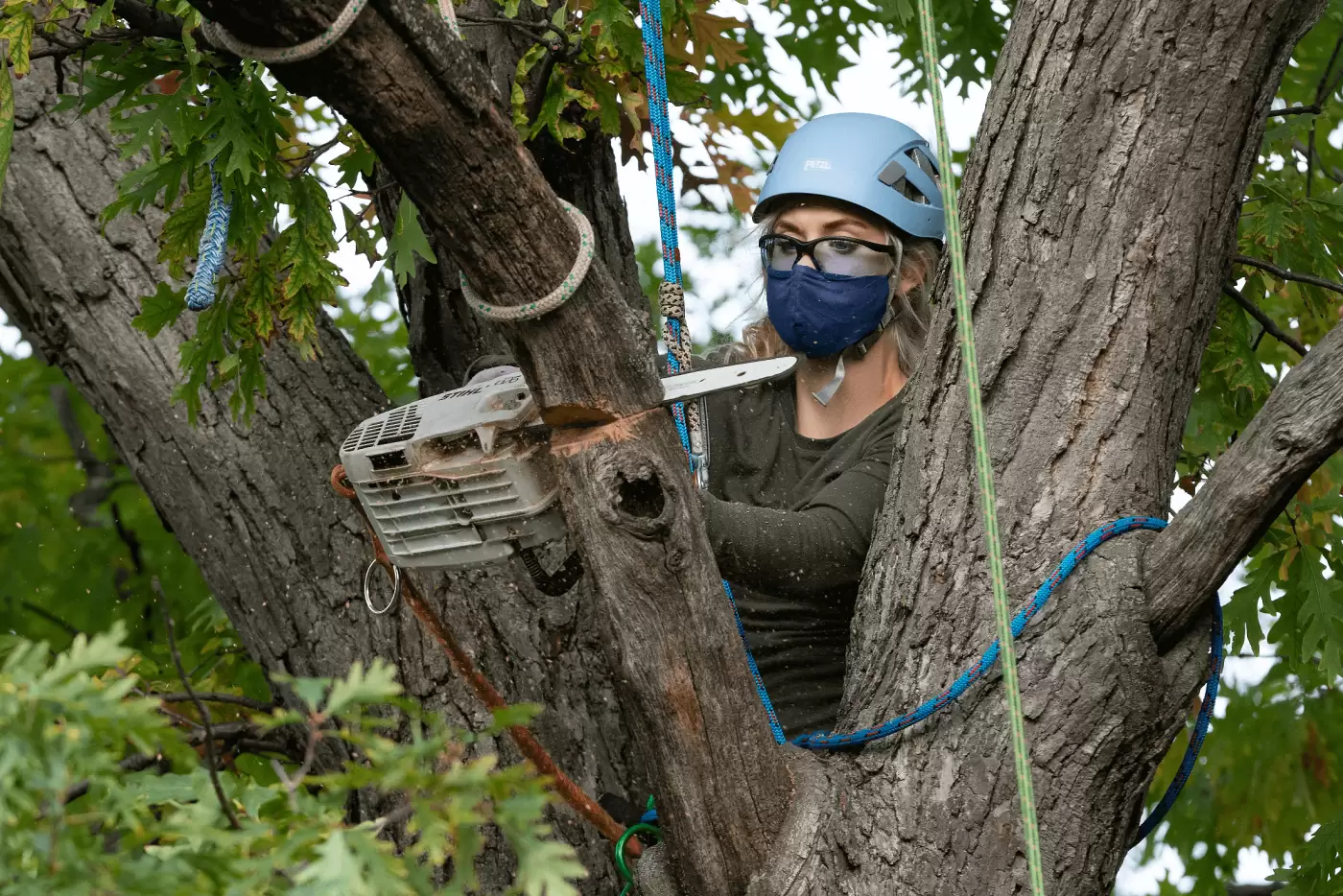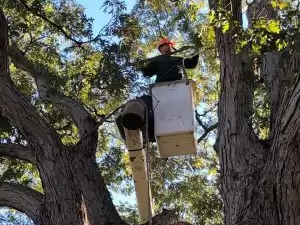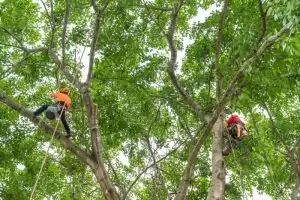Legitimate tree trimming is a fundamental part of tree care and support. Trees upgrade the magnificence of our scenes as well as give various environmental, tasteful, and financial advantages. Managing or pruning trees is an essential piece of keeping them sound, safe, and outwardly engaging. It advances better development, forestalls likely dangers, and can broaden the life expectancy of the tree. While tree trimming offers many advantages, it's essential to take note of that ill-advised or heedless trimming can have hindering outcomes.
Cutting branches inaccurately or too forcefully can pressure the tree, leaving it helpless against sicknesses and irritations. Overeager pruning can bring about debilitated structures, making branches dampen or fall during storms, presenting dangers to property and wellbeing.
Legitimate pruning can animate new development, further develop air dissemination, and lessen the gamble of infections and pervasions. The risk of falling limbs that could cause property damage or harm to people can be reduced by trimming dead or weak branches. Pruning can shape the tree, upgrading its appearance and making it a more alluring piece of your scene. Ordinary, legitimate trimming can expand the existence of a tree, permitting you to partake in its advantages into the indefinite future.
How to Trim a Tree without Killing It?
Wellbeing and Development: Trees, like all living things, need to be cared for in order to grow and stay healthy. Managing helps eliminate dead or infected branches, permitting the tree to allot assets to sound development. Safety: Congested branches can present wellbeing dangers by impeding ways, obstructing electrical cables, or becoming powerless and vulnerable to breaking during storms. Aesthetics: Appropriately managed trees look seriously engaging and can upgrade the general excellence of your scene.Distinguishing signs that your tree needs trimming
Dead or Biting the dust Branches: Dead or passing on branches frequently give no indications of leaves or buds during the developing season. They ought to be eliminated quickly to keep sickness or perversion from spreading. Overcrowding: There may be competition between the branches for light and nutrients if they are crowded together. Diminishing them out can work on the tree's general wellbeing. Low-Hanging Branches: Branches that hang low can impede pathways or vehicles. Managing them can wipe out these blocks. Branches With Pests or Disease: In the event that you notice indications of illness or bug pervasion on a branch, it's fundamental to eliminate it cautiously to forestall additionally spread.When to Trim a Tree the Best?
Lethargic Season: For most trees, the best time for significant pruning is during pre-winter or winter when the tree is torpid. This limits weight on the tree and lessens the gamble of infection transmission. Minor Managing: Light pruning, for example, eliminating dead branches or little upkeep cuts, should be possible all year. Abstain from Pre-summer and Late-spring: When trees are actively growing, late spring and early summer are generally the best times to avoid major pruning. Pruning during this time might energize unnecessary regrowth and make the tree more defenseless against irritations and infections.Pruning Techniques
If you want to trim a tree without damaging it, you need to use the right pruning methods. Various sorts of pruning fill different needs, from elevating solid development to improving feel.Various sorts of tree pruning
Crown Decrease: This strategy includes specifically eliminating branches to lessen the general size and state of the tree. It's valuable for controlling the level and spread of a tree, particularly in the event that it's close to designs or electrical cables. Destroying Deadwood: Eliminating dead or kicking the bucket branches is pivotal for the tree's wellbeing and security. When it falls, deadwood can attract pests and be dangerous. Thinning: To improve air and light penetration, the canopy must be thinned by selectively removing branches. This can lessen the tree's resistance to wind and improve the tree's overall health. Shaping: The goal of shaping or aesthetic pruning is to make the tree look better. It includes specifically managing branches to accomplish a fair and satisfying shape. Instructions for proper pruning in steps Surveying the tree's design: Distinguish Dead or Sick Branches: Begin by recognizing and denoting any dead or infected branches for expulsion. These ought to be your first concern. Think about the Tree's Normal Shape: While molding or diminishing, it means to keep up with the tree's regular shape and design. Stay away from intense changes that can pressure the tree. Search for Crossed or Scouring Branches: Eliminate branches that rub against one another, as they can cause wounds and welcome illness.Picking the right branches to manage:
Choose Secondary Branching Options: While eliminating branches, center around optional branches as opposed to the principal trunk or significant appendages. Keep up with the Branch Collar: Cut branches right external to the branch collar, which is the marginally raised region where the branch meets the storage compartment. Take care not to cut flush with the trunk.Making clean cuts:
Utilize Sharp Apparatuses: Guarantee your pruning apparatuses are sharp to make clean cuts that mend all the more effectively. Make a Legitimate Cut: Utilize a three-slice technique for bigger branches to forestall tearing. To begin with, make an indent cut on the underside of the branch, then a help cut on top, lastly, a clean, marginally calculated cut external to the branch collar.Appropriately discarding trimmed branches:
Eliminate Flotsam and jetsam: Gather up managed branches and flotsam and jetsam expeditiously to keep infection and vermin from influencing the tree. Consider Mulching: Chipping managed branches into mulch can be a maintainable method for reusing tree squander.Unique contemplations for explicit tree species
Different tree species might have one of a kind prerequisites and responsive qualities with regards to pruning. Before you begin managing, research the particular requirements of your tree species to guarantee you're following prescribed procedures.Avoiding Common Mistakes
Tree trimming can be a fragile cycle, and, surprisingly, benevolent endeavors can turn out badly if you don't watch out.Over-Pruning and Under-Pruning
Over-Pruning: This happens when you eliminate such a large number of branches without a moment's delay or remove more foliage than needed. Over-pruning can debilitate the tree, hinder its development, and make it defenseless against illness and vermin. Under-Pruning: On the other hand, under-pruning implies not eliminating an adequate number of branches, prompting congestion and unfortunate air flow. This can bring about an undesirable tree that doesn't flourish. Solution: Track down a harmony between over-pruning and under-pruning by following legitimate pruning strategies. Center around eliminating dead, sick, or crossing branches while safeguarding the tree's regular shape and construction.Injuring the Tree
Creating ill-advised cuts or leaving jagged edges can wound the tree and give passage focuses to infections and irritations. Trees have an ability to surprise to mend, however enormous injuries take more time to close, allowing the tree to remain uncovered. Continuously utilize sharp, clean apparatuses, and make clean cuts right external to the branch collar. Try not to slice excessively near the storage compartment or leaving nails, as both can dial back the recuperating system.Dismissing the Tree's Wellbeing
Managing a tree that is worried, infected, or lacking legitimate consideration can additionally debilitate it. In order for trees to recover from pruning, they must be healthy. Focus on the tree's general wellbeing by giving satisfactory water, supplements, and checking for indications of infection or stress when pruning. Address any medical problems immediately.Beating versus Legitimate Pruning
Beating: Cutting off the upper portion of a tree's main trunk or major branches to lower its height is known as topping. This is exceptionally unfavorable to the tree and ought to be stayed away from. It makes the regrowth less strong, increases the risk of disease, and makes the appearance less appealing. Solution: Rather than fixing, utilize appropriate pruning strategies, for example, crown decrease or particular branch evacuation to control the tree's size and shape while saving its wellbeing.Disregarding the Timing
Pruning at some unacceptable season can pressure the tree and thwart its capacity to recuperate. Solution: Follow the times for your particular species of tree that are recommended for pruning. For the most part, significant pruning is best finished during pre-winter or winter when the tree is lethargic.Caring for Your Tree After Trimming
Tree trimming is only one piece of the situation. To guarantee the drawn out wellbeing and imperativeness of your tree, it's fundamental to give legitimate consideration and support after the managing system.- Watering and Preparing
- Observing for Indications of Stress or Sickness
- The Significance of Mulch
- Pruning Follow-Up
- Tolerance and Perception




